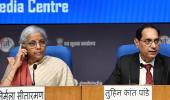Finance Minister (FM) Nirmala Sitharaman has presented a forward-looking Budget, reinforcing the government’s commitment to 'Reform, Perform, and Transform’.

Amid the dual challenges of adhering to the fiscal glide path and supporting demand in a slowing economy, the Budget strikes a delicate balance.
It continues the path of fiscal consolidation while lowering tax rates for the middle class to boost consumption.
This dual approach aims to ensure long-term financial stability while addressing the needs of all sections of society.
The government’s commitment to fiscal prudence is evident in its fiscal deficit target of 4.4 per cent of GDP for FY26, down from 4.8 per cent in FY25.
This move is part of a broader strategy to maintain fiscal discipline while supporting growth.
The Budget projects net borrowings at Rs 11.5 trillion for FY26, aligning with market expectations.
Importantly, the FM laid out a fiscal roadmap for the next five years, which would help rebuild fiscal buffers and provide policymakers with the space to undertake growth-enhancing expenditures as needed.
She announced income tax relief for middle-class households to the tune of $12 billion (0.3 per cent of GDP), which is expected to give a significant boost to urban consumption and savings.
Rationalising the Tax Deduction at Source (TDS) and Tax Collected at Source (TCS) rates simplifies compliance for small taxpayers and eases the tax burden on individuals and small businesses while encouraging voluntary compliance.
The Centre’s capex is projected to grow at 10 per cent year-on-year (Y-o-Y) in FY26, up from 8 per cent in FY25.
Including extra-budgetary resources (IEBR), total capex spend is likely to grow by 11 per cent in FY26, compared with 7 per cent in FY25.
Within total capex, the growth in roads and railways capex (including IEBR) is flat in FY26, compared with 5-7 per cent Y-o-Y growth in FY25.
However, defense capex is projected to grow by 13 per cent Y-o-Y in FY26, an increase from 4 per cent in FY25.
Hence, the pick-up in FY26 is largely led by defense, housing, power, and petroleum.
Agriculture and rural prosperity are central themes in this year’s Budget.
The government has launched Prime Minister Dhan-Dhaanya Krishi Yojana, targeting 100 low-productivity districts to enhance agricultural output, improve irrigation facilities, and promote sustainable farming practices.
The Budget also recognises the critical role of MSMEs in driving economic growth and employment.
To encourage growth and scalability, the government has revised the MSME classification criteria, enhanced credit guarantee covers for micro and small enterprises, and introduced customised credit cards for micro enterprises.
This will benefit millions of entrepreneurs.
Sector-specific measures have also been introduced to boost key industries.
In the textiles sector, the Budget promotes domestic production of technical textiles and introduces duty exemptions on shuttle-less looms to enhance competitiveness.
For the electronics sector, the Budget reduces customs duties on components for mobile phone and EV battery manufacturing, while increasing duties on finished products, supporting the ‘Make in India’ initiative.
From an equity markets perspective, the Budget is not expected to materially alter the earnings trajectory in the coming years.
Sectors like consumption, BFSI, auto, and healthcare are likely to do well.
The consumption boost is positive for consumer durables, two-wheelers, staples, consumer finance, deposit growth for banks, and reducing retail stress.
Incorporating the fiscal announcement and recent measures by the Reserve Bank of India to ease the interbank liquidity deficit should help boost India’s growth.
In conclusion, the 2025-2026 Budget is a comprehensive blueprint for India’s growth, balancing fiscal prudence with inclusive development.
By focusing on agriculture, MSMEs, green energy, and exports, the government aims to create a robust foundation for long-term economic stability.
With its focus on inclusive growth and sustainable development, the Budget sets the stage for India’s continued rise as a global economic powerhouse.
Nilesh Shah is MD, Kotak Mahindra AMC












 © 2025
© 2025